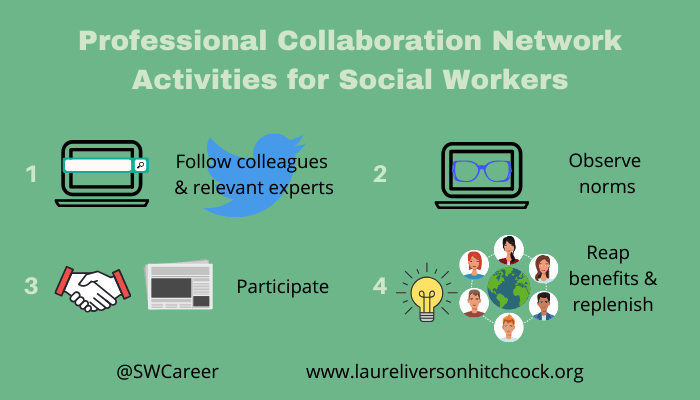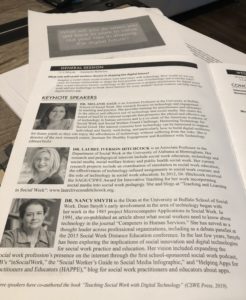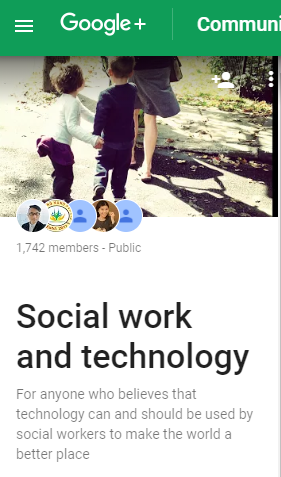Twitter for your Professional Collaboration Network (PCN)
Editor’s Note: This post is one in a series about how technology can be used to develop and sustain one’s professional network. The idea for this post came from a think tank hosted by the University at Buffalo’s School of Social Work in June 2019, looking for a way to teach students in their new online Doctorate of Social Program (DSW) program about how to develop key stakeholder networks in relation to a substantive topic area. In this series, we are exploring the concept of a Professional Collaboration Network (PCN), which are technology-mediated user-centered relationship constellations designed to enhance or enrich connections, knowledge, and professional opportunities. This post covers how you can use Twitter to create and support your PCN.
In light of our living in a time of rapid technological change and our professional mandate to keep up-to-date with the advances in our field, (Council on Social Work Education, 2015; National Association of Social Workers, 2018), social workers may benefit from building a professional collaboration network (PCN). We previously defined what a Professional Collaboration Network is this blog post: What is a professional collaboration network and why do you need one?

In essence, a PCN is created by social workers who connect with other professionals online for the purpose of learning and exchanging information. Prior to the ubiquitous use of the internet, professionals would typically keep up with the latest developments in their field via networking with their peers at conferences and continuing education opportunities, as well as via printed newsletters, magazines and trade publications. Nowadays, there are many technological tools to facilitate interactions with individuals across different disciplines, states or the world. PCNs typically include various online communities such as Twitter, LinkedIn, Facebook, social bookmarking sites and more.
Review of Teaching & Learning in Social Work for 2019

It is that time of year again – the annual review of the Teaching & Learning in Social Work Blog. This will be my fourth year reflecting on the work of this blog; the first end of the year post was in 2016. This year, I am thinking more about my motivation for starting and maintaining this blog for the past seven years. As I think back on why I started Teaching & Learning in Social Work, I’d have to say I wanted to be a more confident writer. Academic writing is not easy. This blog helped me to find my academic voice while allowing me to experiment with writing. I try to be personable in the posts I write, using plain language and concise phrasing. While I can say I am more comfortable with my professional writing, the greatest benefit to this blog is having space to share my work and the work of others in a very non-traditional space. Publishing is a peer-reviewed journal is currency for academics, and it is a narrow, rigid, and polished way to share one’s work. By writing blog posts about my work early in the process, I can share with a wider audience including students, social work practitioners and professionals from other fields. I can also as publish work that may never find a home as a journal article, but is still of value to others. For example, I write frequently about my assignments and classroom activities on this blog. I also post information about my conference presentations here so others can easily reference the materials. Overall, I can say with confidence that writing and publishing Teaching & Learning in Social Work has truly be beneficial and motivating for my academic writing.
For 2019, I had three goals for improving the blog:
#SWTech – An Introduction and History of the Online Group
Editor’s Note: This blog post was written by the following users of the #SWTech Community – Melanie Sage, Assistant Professor of Social Work at the University at Buffalo; Laurel Iverson Hitchcock, Associate Professor of Social Work at the University of Alabama at Birmingham: Jonathan B. Singer, Associate Professor of Social Work at Loyola University and founder of the Social Work Podcast; and Nancy J. Smyth, Professor & Dean at the School of Social Work at the University at Buffalo.
This is an introduction to #SWTech, an online network of social workers interested and engaged with technology for social good. Our goal is to help individuals new to #SWTech learn about the norms, history, and general merrymaking within the community. This statement can also service as a resource to send people who are interested in learning more about #SWTech.
Description
#SWTech is a hashtag used by people and groups interested in the intersection of social work and technology. People use #swtech primarily on Twitter, but the hashtag is occasionally used on other social media platforms such as Facebook or Instagram. This hashtag is used in tweets and other posts on social media to share about such topics as:
#SWDE 2019 – Imagining Social Work Education into the Future: Skills for Social Justice in a Technology-Mediated World
On April 11th, Melanie Sage, Ellen Belluomini, and I presented at the 2019 Social Work Distance Education Conference in San Antonio, TX on a topic that is beginning to get some traction in social work – the future of social work education for practice with technology. Technology is profoundly shaping the world, especially in the delivery of education. Concurrently, services like telehealth, predictive analytics, and technology aids (i.e. Fitbits, apps and home listening devices) affect service delivery. Given these changes, how do social workers promote social justice and support privacy and equity? And consider needs of the vulnerable while harnessing technology for good? How does social work redefine the profession in the face of algorithmic solutions to human problems? Our goal was to introduce a dialogue about what’s happening, where are gaps in social work education, and how programs might reinvent in a rapidly-changing environment.
If you were not all to make the session or didn’t attend the conference, we are sharing information from the presentation, to make the content more accessible to all and to help promote more discourse among social workers about the future of the profession.
Here are the slides from the presentation:
#SWDE2019 Keynote – What role will Social Workers choose in shaping the digital future?

On April 10th, Melanie Sage, Nancy Smyth, and I delivered a keynote speech at the 2019 Social Work Distance Education Conference in San Antonio, TX. We asked social work educators to imagine a world where social workers were innovators with technology. Our goal was to have a conversation and share how we had been talking about technology will writing our book – Teaching Social Work with Digital Technology.
We started our conversation about how social workers could help close the digital justice gap on Twitter, moving from virtual spaces to physical spaces. Many social workers joined in this conversation along the way. We talked about a range of issues from boundary and privacy challenges to accessibility and connection with technology. As Nancy said, “we were near-sighted as a profession. We need to look through the lens of possibilities, not the lens of our fears.”
In this blog post, we are sharing highlights, references, and slides from the keynote. We hope you will help us continue the conversation together and in your places of work and community.
#SWTech: The Beginnings of an Online Community
In just a few days, Google will eliminate its online community platform, Google+, and with it will go the first iteration of our #SWTech Online Community. This has me thinking about the whys and whats of how our #SWTech community started and developed, and how it will soon evolve. This blog post is my first attempt to chronicle the people and platforms that shaped our community. My methods were simple. I sent emails to some members requesting information, and talked over the phone and video calls with others. I readily acknowledge the bias and poor memory that I bring to this brief and simple historical record. In fact, this was a common theme I heard from others. I think Neil Ballantyne, Senior Lecturer at Open Polytechnic of New Zealand and board member of husITa, said it best when I asked him how he discovered the #SWTech group:



